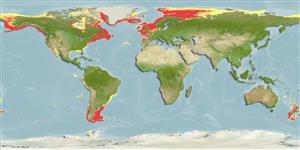Common names from other countries
Environment: milieu / climate zone / depth range / distribution range
Ecologie
; diepteverspreiding 4 - 545 m (Ref. 120471). Subtropical
Arctic, Atlantic and Pacific Oceans. Mostly polar, but also in subtropical and boreal climates.
Length at first maturity / Size / Gewicht / Leeftijd
Maturity: Lm ? range ? - ? cm
It is epizoic on other hydroids, Obelia dichotoma at depths of 20 to 30 m (Ref. 87801). Overall depth range of 4 to 545 m (Ref. 120471). Found in coastal waters and often grew on other animals (Ref. 64386).
Life cycle and mating behavior
Geslachtsrijpheid | Voortplanting | Kuitschieten | Eieren | Fecundity | Larven
Reproduction occurs only in hydroid stage (Ref. 1663, p. 19).
Cairns, S.D., D.R. Calder, A. Brinckmann-Voss, C.B. Castro, D.G. Fautin, P.R. Pugh, C.E. Mills, W.C. Jaap, M.N. Arai, S.H.D. Haddock and D.M. Opresko. 2003. (Ref. 1663)
Status op de Rode Lijst van het IUCN (Ref. 130435)
Status bij CITES (Ref. 108899)
Not Evaluated
Not Evaluated
Gebruik door de mens
| FishSource |
Tools
Meer informatie
Leeftijd/Grootte
Groei
Lengte-gewicht parameters
Lengte-lengte parameters
Morfologie
Larven
Abundantie
Internet-bronnen
Estimates based on models
Preferred temperature
(Ref.
115969): 1.1 - 12.1, mean 7.2 (based on 167 cells).
Prijsklasse
Unknown.
